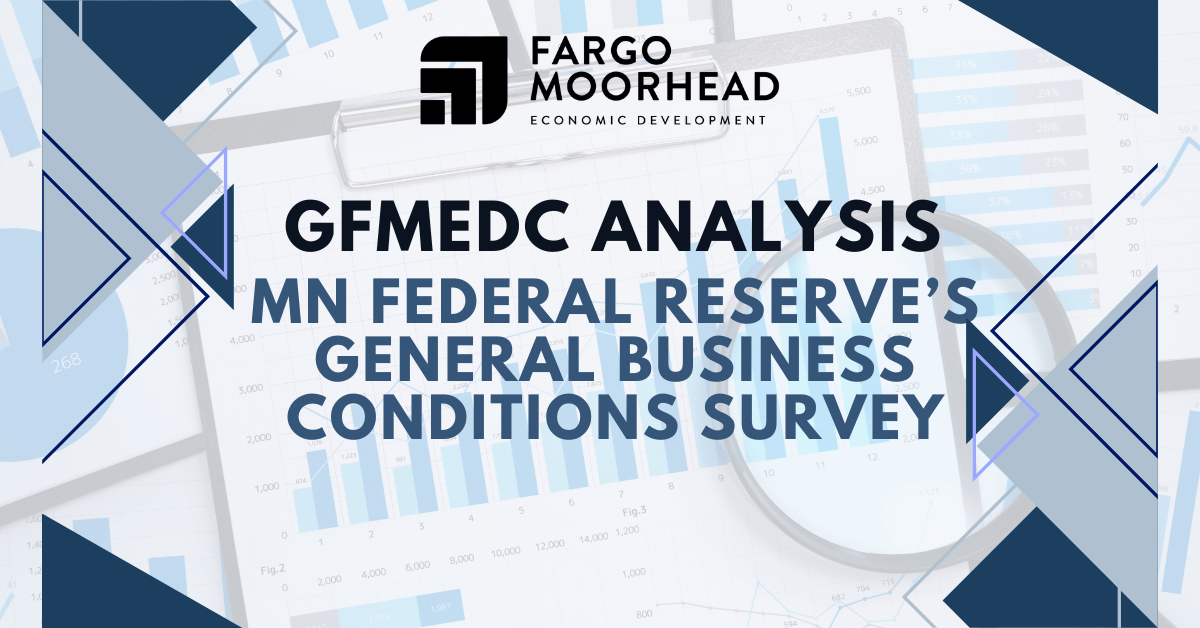GFMEDC Analysis of Local Responses to MN Federal Reserve’s General Business Conditions Survey
You may recall in a previous blog that the GFMEDC has developed a strategic data partnership with the Federal Reserve 9th District (Minneapolis). This partnership gives the GFMEDC the ability to review the General Business Conditions Survey data for Cass and Clay Counties in comparison to similar businesses in the 9th District.
Focusing on the industries of Manufacturing; Finance, insurance, and real estate; Professional, scientific and technical services; and Other, we can analyze the data for trends that indicate our market is out-performing, under-performing or on-pace with peers in the 9th District.
To summarize the large volume of data, we’ve included some highlights below:
The data below reflects the industries mentioned above and the survey was conducted in January 2024. For the FM dataset, 36 survey responses were analyzed, compared to the 9th District dataset of 249 survey responses (FM data has been removed from the larger dataset to obtain a more accurate comparison).
The FM region respondents outperform the 9th District in terms of revenue, revenue projections and profits.
- Whether present revenue data is compared to last quarter, the same time last year or looking forward the next three months, approximately 14% more FM companies are seeing, or expecting, moderate to significant increases in revenue than those in the 9th District.
- While FM companies and those in the 9th District saw the same gains in moderate to significant profit increases in the last quarter compared to the previous quarter, 8% more (39% vs. 31%) FM companies indicated they had moderate to significant profit increases compared to the same period last year. FM companies are also more optimistic than 9th District companies for moderate to significant profit increases in the next three months (33% vs. 21%).
- 52% of FM companies are somewhat optimistic to very optimistic on their business outlook in the next six months compared to 42% of 9th District companies.
Compared to peers in the 9th District, more FM companies are hiring and increasing wages.
- When asked about hiring activities, 13% more (47% vs. 34%) FM companies are hiring to replace turnover compared to those in the 9th District and 17% more (38% vs. 21%) FM companies are hiring additional full-time workers.
- To retain workers, both FM and 9th District companies indicated the same top strategy to retain workers in the last six months: increasing wages. 70% of FM companies increased wages compared to 52% of those in the 9th District.
- Both FM and 9th District companies have increased wages by 1-5+% (FM companies more so at 94% of respondents than 9th district companies at 67%).
FM companies have different top priorities than those in the 9th District.
- 75% of FM companies say the current interest rates are having a modestly negative to significantly negative impact on their business compared to 9th District companies at 63%.
- 34% of FM companies say they aren’t getting enough applicants for positions compared to 19% of 9th District companies.
- 61% of FM companies say that it’s moderately to extremely difficult to find and hire necessary labor compared to 55% of 9th District companies.
In summary, the Greater Fargo Moorhead metropolitan area continues to show recent, year-over-year, and future predictions for economic growth and profitability for respondents at rates stronger than the rest of the District. These results are in line with the trends we have reported over the past couple years, though data indicates our region is more impacted by our strong growth being challenged by the need for new workers.
Disclaimers:
The respondents to the General Business Conditions survey do not come from a random or representative sample, so results should be interpreted carefully.
This survey analysis comes from GFMEDS’s interpretation of the data, not from the Federal Reserve Bank of Minneapolis.


